ch. 12: Learning and memory
1/44
There's no tags or description
Looks like no tags are added yet.
Name | Mastery | Learn | Test | Matching | Spaced |
|---|
No study sessions yet.
45 Terms
which concepts are involved in the computational model of memory
encoding
storing
retrieving
memory works like a computer
encoding
transforming information into a form that can be stored in memory
storing
maintaining the encoded information in memory
retrieving
re-accessing information from the past which has been encoded and stored
memory systems
The human brain categorizes memories based on importance, with emotional events often leading to stronger and clearer memories.
crucial for adaptive behavior
memory compares current situations with past events
memory is categorized to aid in understanding its mechanisms
flashbulb memory
Flashbulb memories are vivid and detailed memories of emotionally charged events. Only the surprising memory will stick out of the event, nothing else.
Examples include the 9/11 attacks, the Challenger explosion, or personal milestones like weddings or the birth of children.
These memories seem more stable and long-lasting than others.
are not separate from general memory, but are
stronger due to emotional arousal during the event, which marks the memory as significant
memory markers and the role of hormones in memory
The brain uses stress hormones released during intense emotional or physical events to "tag" memories as important. These hormones may help encode memories more strongly and make them easier to retrieve later.
theoretical mechanism: The release of stress hormones, such as cortisol, during stressful experiences enhances the encoding process, marking them as significant.
what are the components of memory (memory stages)
acquisition
consolidation
retrieval
ex. A person’s memory of a traumatic car accident might be acquired in the moment (acquisition), consolidated over time through frequent recollection (consolidation), and retrieved when the individual recalls the event years later (retrieval).
hormones affect all stages of memory. Ex. cortisol may enhance encoding and consolidation of emotional memories
when you don’t remember something, it could be many things. Could be that you acquired, consolidated something, but can’t retrieve it or other things
acquisition
The process of receiving and encoding information.
the process of acquiring the memory
consolidation
The stabilization and storage of memories in long-term memory.
treatment would have to be very soon after the event because if you wait too long, the memory will already have been consolidated
retrieval
The ability to access stored memories when needed.
what are 2 types of memory systems
non-human memory systems: Memory is not unique to humans. Even immune systems (e.g., in vertebrates) have memory to identify and respond to previous infections.
memory in technology: Computers and smartphones also have memory systems, which enter, store, and retrieve information.
what are the types of memory
short-term memory
working memory
long-term memory
procedural memory
declarative memory
short term memory
temporary storage of information
duration: seconds to minutes
ex. retaining a phone number briefly
rehearsal moves information to long-term memory
long-term memory
permanent storage of information
duration: days, weeks, years
capacity: no known upper limit
ex. remembering facts for exams
procedural (implicit) memory
memory for skills (ex. riding a bike)
skill learning
priming: being more likely to use a word you recently heard
conditioning: salivating when you see a favourite food
declarative or explicit memory
memory for facts and events
episodic memory: whole episodes of your life (ex. remembering you high school grad)
semantic memory: facts about the world that you can remember without knowing how you learned it (ex. knowing that 2+2=4 but not knowing who taught you that)
**these memories are dependent on medial temporal lobe
working memory
a type of short term memory
brain keeps things in mind while you’re trying to do a task (temporarily)
when you need to do some type of operation on the short term memory (ex. calculate 692+38), while additionally storing it in short term memory
ex. “turn right, then go upstairs”
hormones’ role in memory
Stress hormones influence the conversion of short-term memories into long-term ones, enhancing recall and memory stability.
The Yerkes-Dodson Law
Learning performance is affected by arousal. The relationship is inverted U-shaped—performance is best at moderate levels of arousal, while too low or too high arousal impairs learning.
ex. You perform well in an exam with moderate anxiety, but extreme stress can lead to poor performance.
hormonal influence: Hormones like adrenaline affect arousal levels and, consequently, learning performance. The right level of arousal enhances focus and memory consolidation.
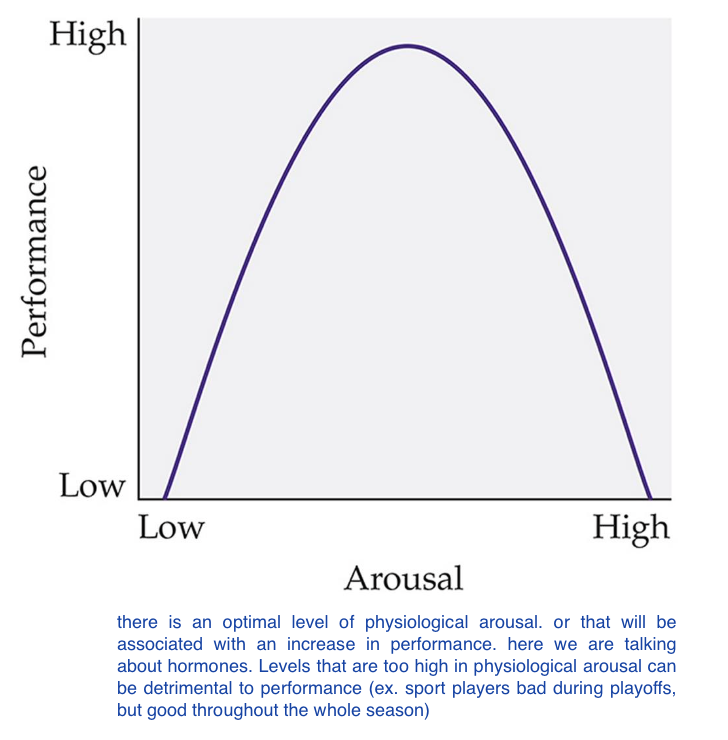
what are the types of learning
non-associative learning: Learning in response to a single stimulus
sensitization
habituation
associative learning
classical conditioning
operant conditioning
active/ passive avoidance
appetitive learning
sensitization
Increased response to a stimulus after repeated exposure or after a strong initial stimulus
hormonal influence: Stress hormones like cortisol can enhance sensitization or prevent habituation, depending on the context.
habituation
Decreased response after repeated exposure to a harmless
stimulus
hormonal influence: Stress hormones like cortisol can enhance sensitization or prevent habituation, depending on the context.
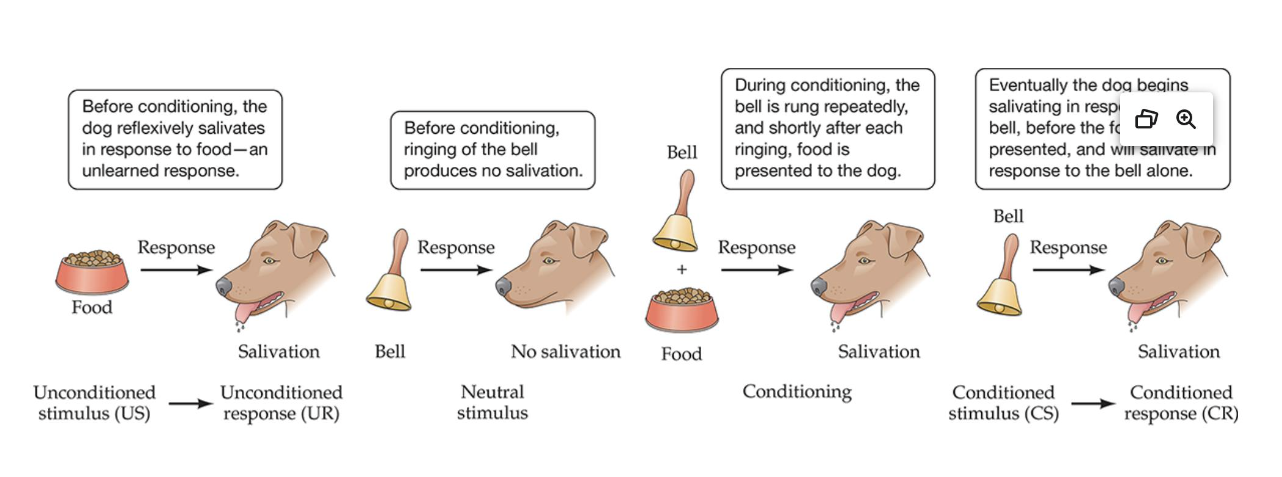
classical conditioning (Pavlov)
Learning through association. A neutral stimulus (bell) is paired with an unconditioned stimulus (food) to elicit a conditioned response (salivation).
Example: Pavlov’s dogs learned to salivate at the sound of a bell after repeated pairing with food.
Hormonal Influence: Stress hormones can enhance the formation of associations in classical conditioning by strengthening neural connections.
Operant conditioning (Skinner’s learning theory)
Learning occurs when behaviors are reinforced. A subject learns to associate a behavior with its outcome (reinforcement).
Example: A rat in a Skinner box presses a lever to receive food, eventually learning to press the lever more often.
Hormonal Influence: Hormones such as dopamine play a role in reinforcing behaviors by increasing the reward value of a stimulus.
what is the role of hormones in learning and memory
Hormones like cortisol, adrenaline, and dopamine impact the brain’s ability to encode, consolidate, and retrieve memories. Stress hormones play a particularly crucial role in emotional memory formation.
emotional memory does not need to be about something bad, but seems to be more powerful when it was something stressful or scary
ex. The memory of a traumatic event (e.g., a car accident) is often clearer and more vivid due to the release of stress hormones during the event.
summary: Hormones interact with learning and memory systems, influencing everything from acquisition to retrieval.
active avoidance
a form of associative learning where an animal must engage in a behavior to avoid an unpleasant stimulus.
Example: In a test involving a mouse, the animal is placed in a box with two compartments. A bell sounds, followed by a mild foot shock. The mouse can avoid the shock by moving to the other compartment. Over several trials, the mouse learns to associate the bell with the foot shock, prompting it to move to the other compartment upon hearing the bell.= stronger memory
how is memory and forgetting tested after training of mice in the active avoidance condition
After training, the strength of the mouse's learned association is tested by returning the mouse to the shuttle box after a delay. The mouse’s ability to avoid the shock when the bell rings is used to measure the strength of its memory. The memory tends to fade over time, and stronger shocks lead to longer-lasting memories.
passive avoidance
involves the inhibition of a behavior that the animal would otherwise engage in, to avoid an unpleasant stimulus.
avoiding involves not taking action as a result of a learned negative outcome (ex. staying home to not go to school)
suppressing some type of behavior that would otherwise be exhibited
Example: A mouse prefers dark compartments but receives a foot shock when it enters the dark side of a box. Over time, the mouse learns to stay in the illuminated compartment to avoid the shock, inhibiting its natural inclination to move into the dark compartment.
how is memory strength tested in the passive avoidance condition for mice
The strength of memory for this behavior is indicated by the amount of time the mouse stays in the illuminated compartment. The longer the mouse stays in the light, the stronger the memory of the noxious experience
fear conditioning
occurs when an animal learns to associate a neutral stimulus, such as a sound or light, with an aversive stimulus like a foot shock.
Over time, the animal freezes when it hears the warning sound, even without the shock
typically tested with classical conditioning
what is the hormonal influence on memory in fear conditioning
often used to study the effects of hormones on memory.
The stress induced by the shock can alter levels of glucocorticoids and other hormones, which may affect the animal’s memory of the experience.
how does the fear response in the brain work
see a threatening stimulus
identify the stimulus with your eyes (processed by the sensory organ (aka thalamus)
signal is transferred to the sensory cortex to the hippocampus
then sent to the amygdala
low road fear response
this is the first reaction:
stimuli
sensory thalamus
*takes low road to
The amygdala triggers hypothalamus to trigger the sympathetic NS through the release of hormones
emotional response
**the “just in case” route
the quick and dirty route
the amygdala dos not discriminate between threatening and non-threatening stimuli
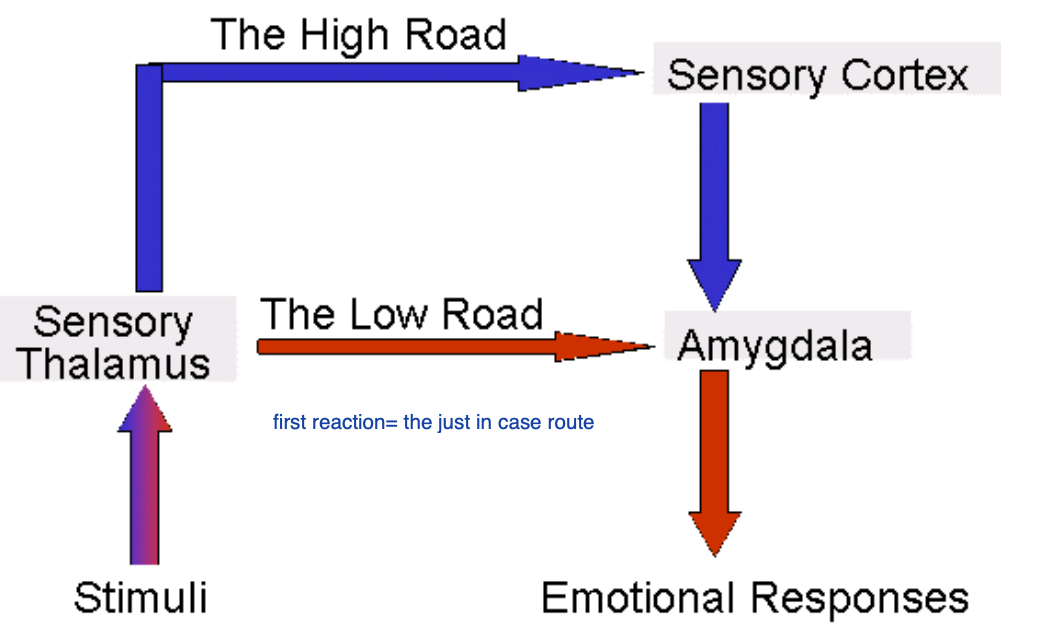
the high road fear response
this route is activated a few seconds after the high road
slow and precise route
amygdala discriminates
stimuli
sensory thalamus
sensory cortex
amygdala
low vs high route—which is better?
none. both are needed for proper functioning
the stress response begins with the amygdala that starts the whole chain of stress response
memory
Memory refers to the process of encoding, storing, and retrieving information
multi-store memory model (Atkinson and Shiffrin (1968))
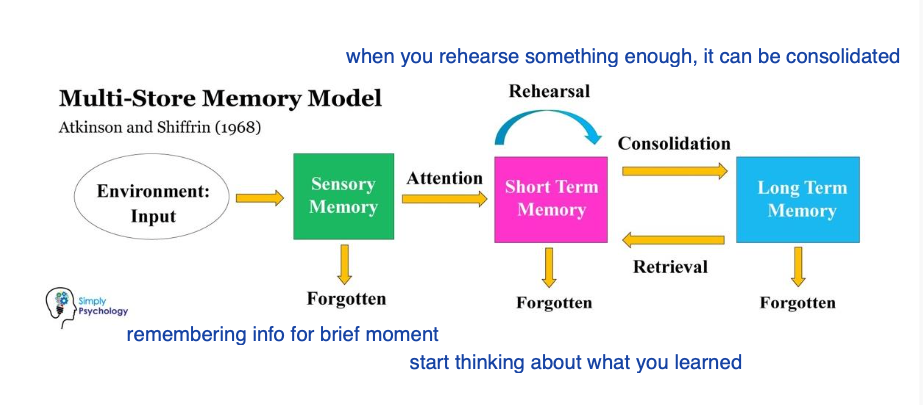
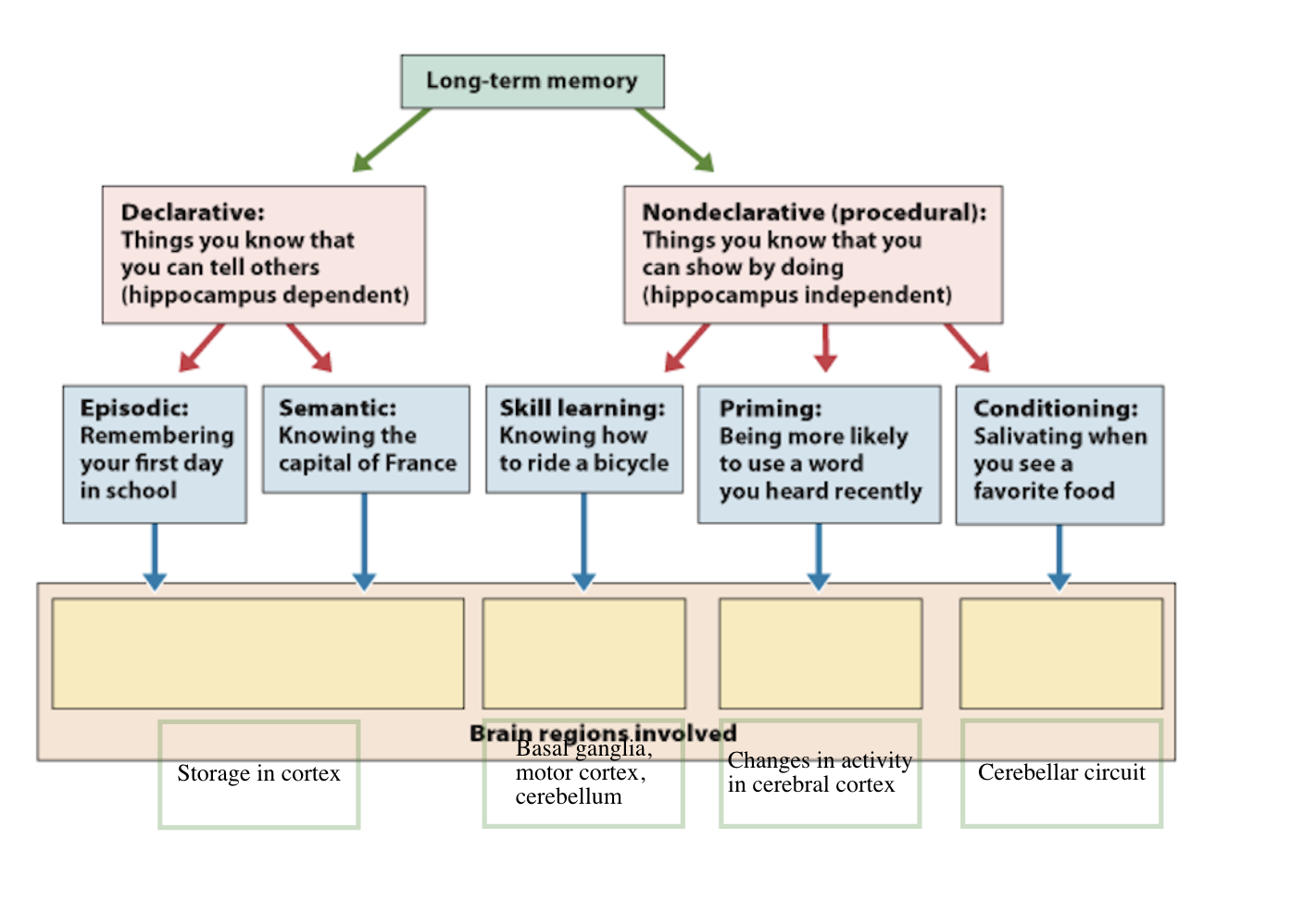
long term memory types
declarative (explicit): things you know that you can tell others
episodic
semantic
procedural (implicit): things you know that you can show by doing
skill learning (procedural)
priming
conditioning
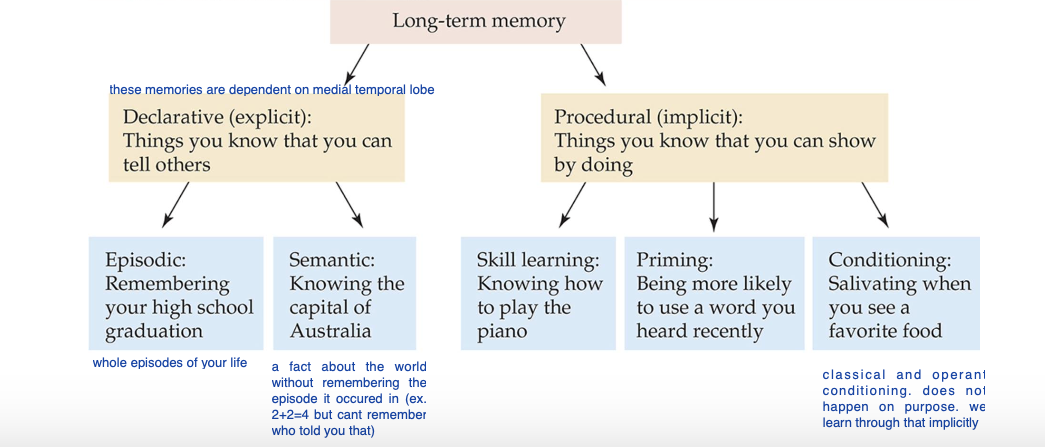
learning
- a process that expresses itself as an adaptive change in behavior in response to experience.
difference between fatigue and habituation
fatigue= The messages do not reach the CNS
habituation= the messages reach the CNS, but they are simply ignored
extinction
occurs when an individual stops responding to a stimulus following a series of nonreinforced experiences or trials
Individual has either unlearned what was previously learned or learned something new to replace the previous information
appetitive learning
- Another type of associative learning
When an animal learns to perform some task that is rewarded with food, water or some other pleasant experience (ex. Learning to navigate a maze with food around)
working vs reference memory
o Working memory: typically involves short-term memory for info that changes on a regular basis (similar to declarative)
o Reference memory: associations or discriminations requiring repetitive learning, as in learning the rules of a task or how to navigate around an environment such as a maze
spatial memory
- memory for the location of items or places in space
o May include finding a reference in a textbook, locating a classroom